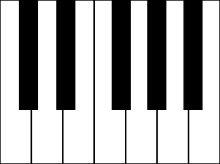Chromatic scale
Chromatic instruments, such as the piano, are made to produce the chromatic scale, while other instruments capable of continuously variable pitch, such as the trombone and violin, can also produce microtones, or notes between those available on a piano.
As a result, in 12-tone equal temperament (the most common tuning in Western music), the chromatic scale covers all 12 of the available pitches.
[4] The twelve notes of the octave—all the black and white keys in one octave on the piano—form the chromatic scale.
Its spelling is, however, often dependent upon major or minor key signatures and whether the scale is ascending or descending.
The rising scale is Do, Di, Re, Ri, Mi, Fa, Fi, Sol, Si, La, Li, Ti and the descending is Ti, Te/Ta, La, Le/Lo, Sol, Se, Fa, Mi, Me/Ma, Re, Ra, Do, However, once 0 is given to a note, due to octave equivalence, the chromatic scale may be indicated unambiguously by the numbers 0-11 mod twelve.
Tone rows, orderings used in the twelve-tone technique, are often considered this way due to the increased ease of comparing inverse intervals and forms (inversional equivalence).
Due to a different tuning technique, the twelve semitones in this scale have two slightly different sizes.
Many other tuning systems, developed in the ensuing centuries, share a similar asymmetry.
In 5-limit just intonation the chromatic scale, Ptolemy's intense chromatic scale[citation needed], is as follows, with flats higher than their enharmonic sharps, and new notes between E–F and B–C (cents rounded to one decimal): The fractions 9⁄8 and 10⁄9, 6⁄5 and 32⁄27, 5⁄4 and 81⁄64, 4⁄3 and 27⁄20, and many other pairs are interchangeable, as 81⁄80 (the syntonic comma) is tempered out.



